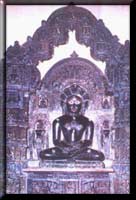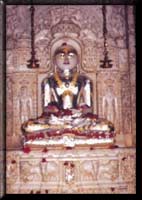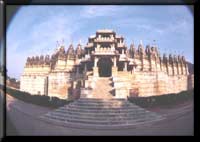|

Mulnayak
| Tirth |
Historicity
| Other Temples |
Works of art and Sculpture |
Guidelines |
Trust
|
Photo Gallery
Mulnayak: Nearly 180 cms. high, white -colored idol of
Bhagawan Adishvar in the Padmasana posture.
Tirth: It
is in the Midst of natural beauty on the Arvalli hills.
Historicity: The Ranakpur tirth was established by Sheth
Sanghavi Dharana Shah and his younger brother Ratna Shah, advisors of King Kumbha. They
saw in a dream the god’s place of residence named Nalinigulm. (It is in the twelfth
devlok.) That shape is given to this temple. The foundation stone was laid in the year
1433 of the Vikram era. Seven metals are used - gold, silver, bell - metal, brass, lead,
copper, zink etc. The foundation is 35 feet deep under the ground and the temple is at a
height of 102 feet from the ground. The land under the temple is of 48 thousand square
feet. There are 1444 pillars. The whole temple is on pillars.The workmanship of each
pillar is different. This temple has 84 idols. They suggest that 84 rotations of the wheel
of this world can be got rid of here. A flag is raised on the fifth day of the bright half
of the month of Fagan.
Other Temples: Besides this, there are temples of Bhagawan Parshvanath and Bhagawan
Neminath. The sun temple and the temple of Chakreshvaridevi are also there. From artistic
and cultural viewpoints.
Works of art and Sculpture: From artistic and cultural viewpoints, the whole
temple is beautiful, splendid, matchless and outstanding among many wonders of the world.
There are 24 pavilions in the - 4 big Meghamandaps and 20 small Rangamandaps. Every
pavilion has a different artistry. 76 small temples and 8 groups of five tirths remind us
of Nadol and Varkana in the east and Nadlai and Muchhala Mahavir in the south. In the
temple, there are many things worth seeing. From the top of the steps of the chief gate
(the western gate), one sees very splendid carvings of leaves of the wish - fulfilling
tree. Like the wish - fulfilling tree, the carvings on the leavse fulfil the wishes of the
pilgrims. On entering the temple, one sees to the right the idol of Diwanji, the mason, a
native of Mandara. He was a yogi and lived in Sadhu’s dress. By the grace of his
goddess, he made a plan of this temple. His descendents live there even today. They do the
rapairing work of the temple. To the left inside the temple, there is an idol of Dharana
Shah. The temple was built at the cost of 15 crores of rupees in those days. His idol is
made in a pillar so as to avoid the propaganda of his name and always he able to see God
well. The Rayan tree which was planted by Dharna Shah 500 years ago, is present even
today. The idols of the feet of Bhagawan Risabhdev are there to remind us that Bhagawan
Risabhdev attained omniscience under a Rayan tree. In the center to the right of the
temple, Samavasaran of Bhagawan Mahavir is very artistically constructed with marble
stone. When Bhagawan is giving sermons, the audience is sitting on three sides. King
kumbhaji wished to make Kirtistambh for his fame. But as divine power would heve it, it
was not completed and remained incomplete. It is called adhuro thambhalo (incomplete
pillar). The idol of Bhagawan Mahavir Swami and Risabhdev are face to face in the ambient
passage. The idols are polished with real gems. They shine like glass. Air, water and
seasons have no effect on these idols. They shine more brightly in the dark. These idols
are 61 inches high. Powder is made of not one or two tolas of gems but many kilograms of
gems Many chemicals are mixed with the powder. Even after 600 years, the idols shine more
and more brightly in darkness. The idols in the ceilings of the gates to the east and to
the west have one head and five bodies. The incident of the harassment caused by Kamath to
the thousand hooded Parshvanath is very artistically carved. The tails of male snakes and
female snakes are shown entangled. Sixteen female snakes help the male snakes to protect
Bhagawan. The tails of male snakes and female snakes are very artistically interwoven and
it seems that there is net - work of tails. It is a special feature of this workmanship
that the whole carving is done on a single stone. The model of Shetrunjay was well
designed to give an artistic description when the means and resources were not
scientically developed. The workmanship of the model is beautiful and praiseworthy. The
idol of Bhagawan Parshvanath is made out of touchstone. The dolls in the domes are very
splendid. The summit of the temple has the built - up area 136 feet. The summit is of
plaster and not of marble. It is, therefore, not weighty. It is praiseworthy that the
incident of harassment to Bhagawan Parshvanath is very vividly depicted. The temple is so
artistically built that one can see God face to face from any corner. Though there are as
many as 1444 pillars, not a single pillar comes in the way and the ventilation is equally
good everywhere. The temple is so minutely sculptured that in the cold season, one does
not feel cold in the temple and in the hot season, one feels cold in the temple. In the
construction of the temples, walls are not used at all. In short, even in the modern
scientific age, no architect can build such a temple and no engineer can make such a plan.
Every pillar displays different artistry and carving design. Every picture has a different
significance. Under the influence of the fifth era, the carving and significance are shown
by mere stones but in the golden age, every doll would no doubt look dancing. The two
pairs of bells are made of metal and they weigh 13 maunds. In each pair, one is a male and
the other is a female. One produces a low sound and the other produces a heavy sound. The
sound reaches as far as three miles. The sound of Om is produced in a lotus in thr form of
a navel and passes into the aperture at the crown of head. It lasts for one minute. The
chandelier of the ceiling of the open square of the temple is pulled low at the center.
This cannot be imagined. How the weight of stones is kept hanging unsupported, is a
puzzle.
Guidelines: The nearest railway station of Falna is at a
distance of 35 Kilometers and the nearest at town of Sadadi is at a distance of 8
kilometers. Bus service and private vehicles are available. There is a vast dharmashala
near the temple. There is also a bhojanashala. Owned by the Govt. of Rajasthan, there are
also guest - houses equipped with modern facilities.
Trust: Sheth Shri Anandji Kalyanji Pedhi, Ranakpur, Dist :
Pali, State : Rajasthan, India.
Bhagawan Adishvar
 

|

